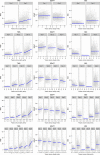Multivariate clustering of progression profiles reveals different depression patterns in prodromal Huntington disease
- PMID: 26011117
- PMCID: PMC4640959
- DOI: 10.1037/neu0000199
Multivariate clustering of progression profiles reveals different depression patterns in prodromal Huntington disease
Abstract
Objective: Although Huntington disease (HD) is caused by an autosomal dominant mutation, its phenotypic presentation differs widely. Variability in clinical phenotypes of HD may reflect the existence of disease subtypes. This hypothesis was tested in prodromal participants from the longitudinal Neurobiological Predictors of Huntington Disease (PREDICT-HD) study.
Method: We performed clustering using longitudinal data assessing motor, cognitive, and depression symptoms. Using data from 521 participants with 2,716 data points, we fit growth mixture models (GMM) that identify groups based on multivariate trajectories.
Results: In various GMM, different phases of disease progression were partitioned by progression trajectories of motor and cognitive signs, and by overall level of depression symptoms. More progressed motor signs were accompanied by more progressed cognitive signs, but not always by higher levels of depressive symptoms. In several models, there were at least 2 groups with similar trajectories for motor and cognitive signs that showed different levels for depression symptoms-one with a very low level of depression and the other with a higher level of depression.
Conclusions: Findings indicate that at least intermediate HD progression might be associated with different levels of depression. Depression is one of the few symptoms that is treatable in HD and has implications for clinical care. Identification of potential depression subtypes may also help to select appropriate patients for clinical trials.
(c) 2015 APA, all rights reserved).
Figures

References
-
- Andrew SE, Goldberg YP, Kremer B, Telenius H, Theilmann J, Adam S, Hayden MR. The relationship between trinucleotide (CAG) repeat length and clinical features of Huntington's disease. Nature Genetics. 1993;4:398–403. - PubMed
-
- Barone P, Poewe W, Albrecht S, Debieuvre C, Massey D, Rascol O, Weintraub D. Pramipexole for the treatment of depressive signs in patients with Parkinson's disease: a randomised, double-blind, placebo-controlled trial. Lancet Neurology. 2010;9:573–580. - PubMed
-
- Beck AT, Steer RA, Brown GW. Beck Depression Inventory-II Manual. The Psychological Corporation; NY: 1996.
Publication types
MeSH terms
Grants and funding
LinkOut - more resources
Full Text Sources
Other Literature Sources
Medical

